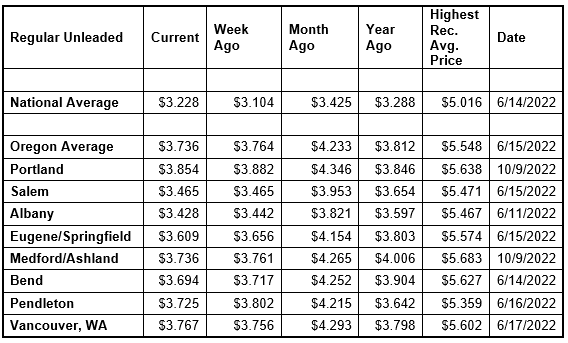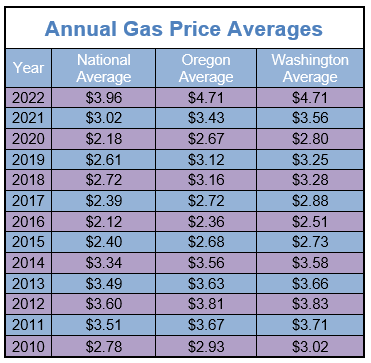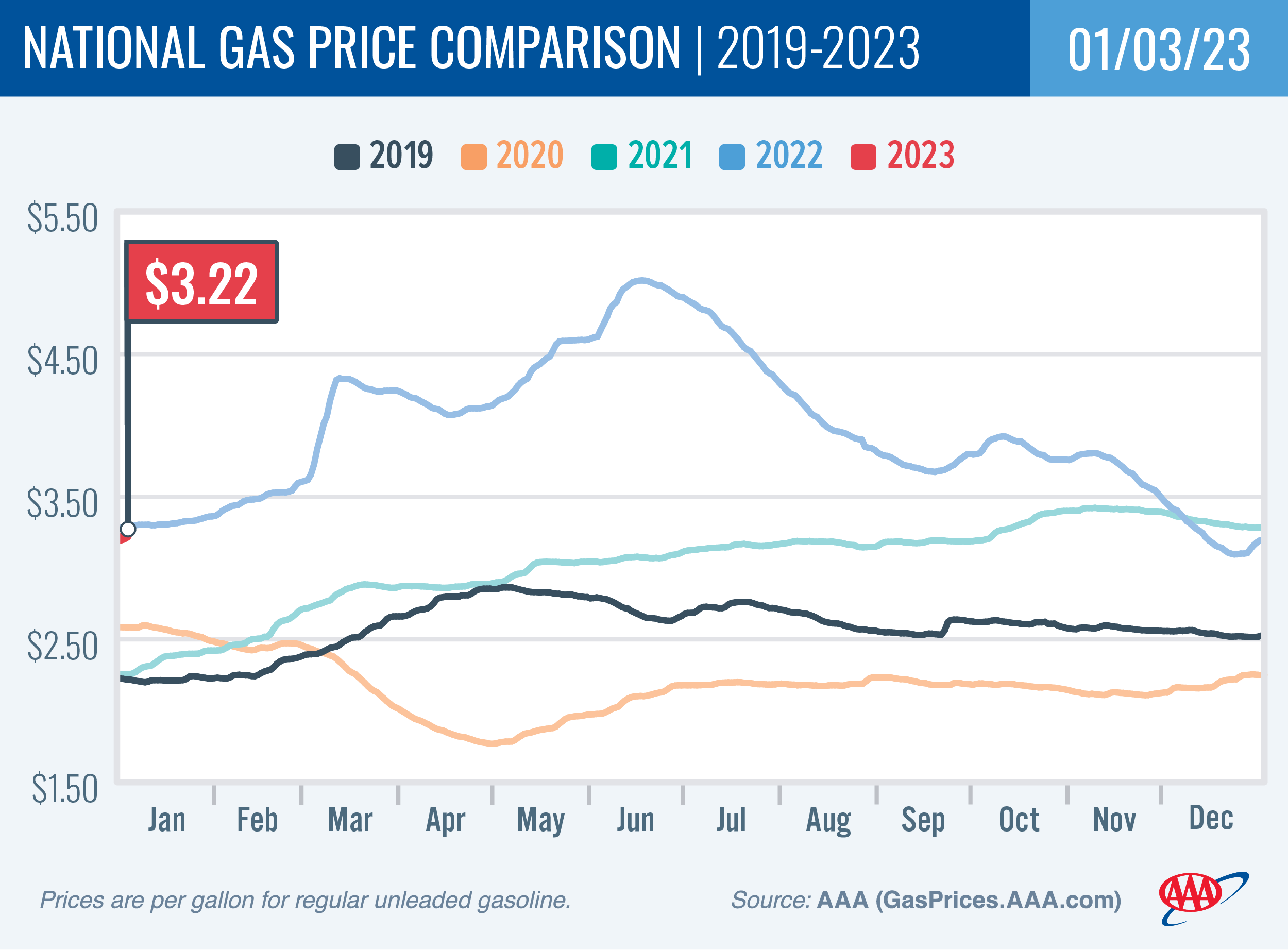Oregon is one of only 10 states with a weekly decline
PORTLAND, Ore., – The late December winter storm that slammed much of the country with snow, ice and frigid temperatures caused gas prices to spike, as refineries as far south as Texas and the Gulf Coast were forced to shut down temporarily. The storm also caused holiday travelers to fuel up and hit the road early to beat the bad weather, leading to a jump in overall gas demand. For the week, the national average for regular unleaded shoots up 12 cents to $3.23. The Oregon average slips three cents to $3.74.

“Gas prices will likely climb a little more before settling down. It will take some time for production to catch up, and for consumers to return to seasonal driving patterns after the holidays,” says Marie Dodds, public affairs director for AAA Oregon/Idaho. “Oregon and other West Coast states have been relatively insulated from these increases because of our distant location from the impacted refineries.”
2022 will go down as a record year with a national annual average of $3.96 and an Oregon annual average of $4.71. These are the highest annual averages ever.

The national average began 2022 at $3.29 on January 1 and ended the year at $3.20 on December 31. It peaked at $5.02 on June 14, 2022. The lowest price for the national average in 2022 was just under $3.10 on December 23.
The Oregon average began 2022 at $3.80 and ended the year at $3.74. It peaked at $5.55 on June 15, 2022. The lowest price for the Oregon average in 2022 was $3.74 on December 31.
Crude oil prices began 2023 around $80 per barrel. Crude prices have remained between about $71 and $81 for the last month. Crude reached a recent high of $122.11 per barrel on June 8. The all-time high for WTI crude oil is $147.27 in July 2008.
Crude prices rose dramatically leading up to and in the first few months of Russia’s invasion of Ukraine. Russia is one of the world’s top oil producers and its involvement in a war causes market volatility, and sanctions imposed on Russia by the U.S. and other western nations resulted in tighter global oil supplies. Oil supplies were already tight around the world as demand for oil increased as pandemic restrictions eased. A year ago, crude was around $76 per barrel compared to $78 today.
Crude oil is the main ingredient in gasoline and diesel, so pump prices are impacted by crude prices on the global markets. On average, about 56% of what we pay for in a gallon of gasoline is for the price of crude oil, 20% is refining, 11% distribution and marketing, and 14% are taxes, according to the U.S. Energy Information Administration.
Demand for gasoline in the U.S. rose due to holiday travel from 8.7 million b/d to 9.3 million b/d for the week ending December 23. This compares to 9.7 million b/d a year ago. Total domestic gasoline stocks fell by 3 million bbl to 223 million bbl. More demand and less supply pushed pump prices higher.
Quick stats
Oregon is one of only 10 states with lower prices week-over-week. Utah (-7 cents) has the largest weekly drop, followed by Idaho (-4 cents), and Oregon (-3 cents). Delaware (+33 cents) has the largest week-over-week increase, followed by Florida (+30 cents) and Maryland (+25 cents).
Hawaii ($5.03) is the state with the most expensive gas in the nation for the sixth week in a row and is the only state with an average at or above $5 a gallon. California ($4.43) is second. These are the only two states with averages at or above $4 a gallon. This week 33 states and the District of Columbia have averages in the $3-range, and 15 states have averages below $3 a gallon.
The cheapest gas in the nation is in Georgia ($2.78) and Kansas ($2.83). For the 103rd week in a row, no state has an average below $2 a gallon.
The difference between the most expensive and least expensive states is $2.25 which continues to be stark.
Oregon is one of 49 states and the District of Columbia with lower prices now than a month ago. The national average is 20 cents less and the Oregon average is 50 cents less than a month ago. Oregon has the sixth-largest monthly decrease in the nation. Arizona (-56 cents) and Idaho (-54 cents) have the largest monthly declines. Florida (-1 cent) has the smallest. Texas (+6 cents) is the only state with a monthly increase.
Oregon is one of 39 states with lower prices now than a year ago. The national average is six cents less and the Oregon average is eight cents more than a year ago. Montana (-41 cents) has the largest year-over-year decline. Hawaii (+70 cents) has the biggest year-over-year rise.
West Coast
The West Coast region continues to have the most expensive pump prices in the nation with six of the seven states in the top 10. This is typical for the West Coast as this region tends to consistently have fairly tight supplies, consuming about as much gasoline as is produced. In addition, this region is located relatively far from parts of the country where oil drilling, production and refining occurs, so transportation costs are higher. And environmental programs in this region add to the cost of production, storage and distribution.
| Rank | Region | Price on 1/3/23 | ||
| 1 | Hawaii | $5.03 | ||
| 2 | California | $4.43 | ||
| 3 | Nevada | $3.98 | ||
| 4 | Washington | $3.87 | ||
| 5 | Oregon | $3.74 | ||
| 6 | Alaska | $3.71 | ||
| 7 | Pennsylvania | $3.63 | ||
| 8 | District of Columbia | $3.48 | ||
| 9 | Idaho | $3.43 | ||
| 10 | New York | $3.42 |
As mentioned above, Hawaii is the most expensive state in the nation, with California, Nevada, Washington, Oregon, and Alaska rounding out the top six. Arizona is 13th. Oregon is fifth most expensive for the eighth week in a row.
All states in the West Coast region are seeing relatively small week-over-week changes. California (+6 cents) has the largest weekly increase in the region. Oregon (-3 cents) has the largest weekly decline in the region.
The refinery utilization rate on the West Coast is steady, going from 87.4% to 87.2% for the week ending December 23. This rate has ranged between about 76% to 93% in the last year.
According to EIA’s latest weekly report, total gas stocks in the region increased from 30.88 million bbl. to 31.18 million bbl.
Oil market dynamics
A weaker dollar contributed to rising crude prices last week. Crude oil is priced in U.S. dollars so when the dollar loses value, crude oil becomes less expensive for investors using other currencies. Crude prices rose despite the EIA reporting that total domestic commercial crude stocks increased by 800,000 bbl to 419 million bbl. The increase signals that oil demand may be weakening amid ongoing market concerns that a recession or economic slowdown could occur this year. If economic growth falters, crude demand will likely drop alongside prices.
At the close of Friday’s formal trading session, WTI increased by $1.86 to settle at $80.26. Markets were closed Monday in observance of the New Year’s Day holiday. Today crude is trading around $78, compared to $80 a week ago. Crude prices are about $3 more than a year ago.
Drivers can find current gas prices along their route with the free AAA Mobile app for iPhone, iPad and Android. The app can also be used to map a route, find discounts, book a hotel and access AAA roadside assistance. Learn more at AAA.com/mobile.

Diesel
For the week, the national average adds a penny to $4.68 a gallon. The record high is $5.816 set on June 19. The Oregon average loses five cents to $4.79. The record high is $6.47 set on July 3. A year ago the national average for diesel was $3.57 and the Oregon average was $3.85.
Find current fuel prices at GasPrices.AAA.com.
AAA news releases, high resolution images, broadcast-quality video, fact sheets and podcasts are available on the AAA NewsRoom at NewsRoom.AAA.com.
Find local news releases at https://oregon.aaa.com/community/media/media-contacts.html


